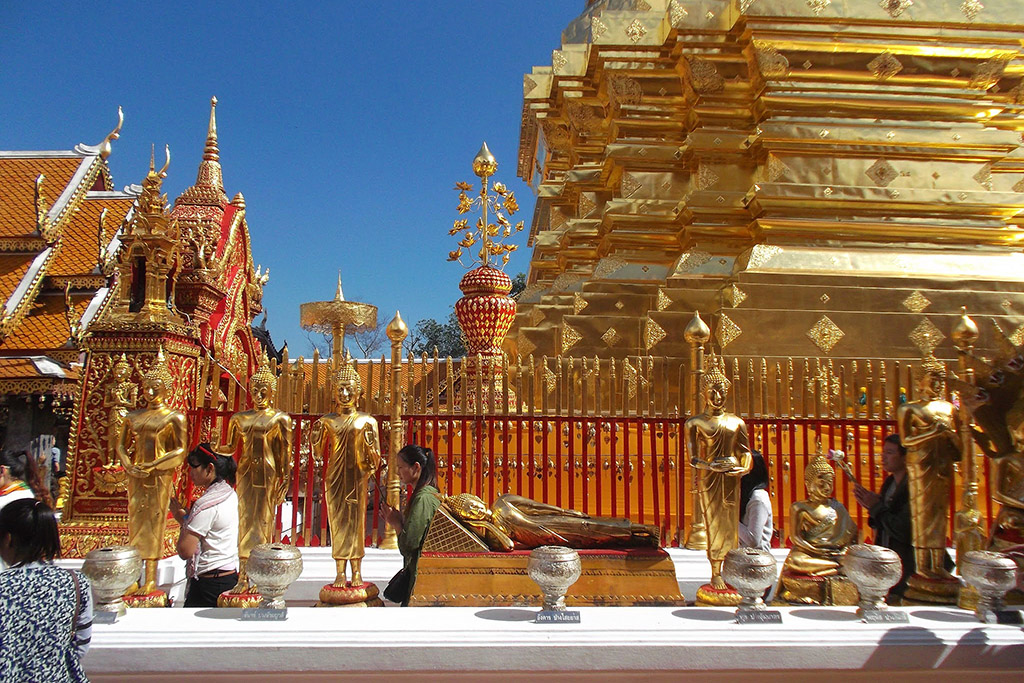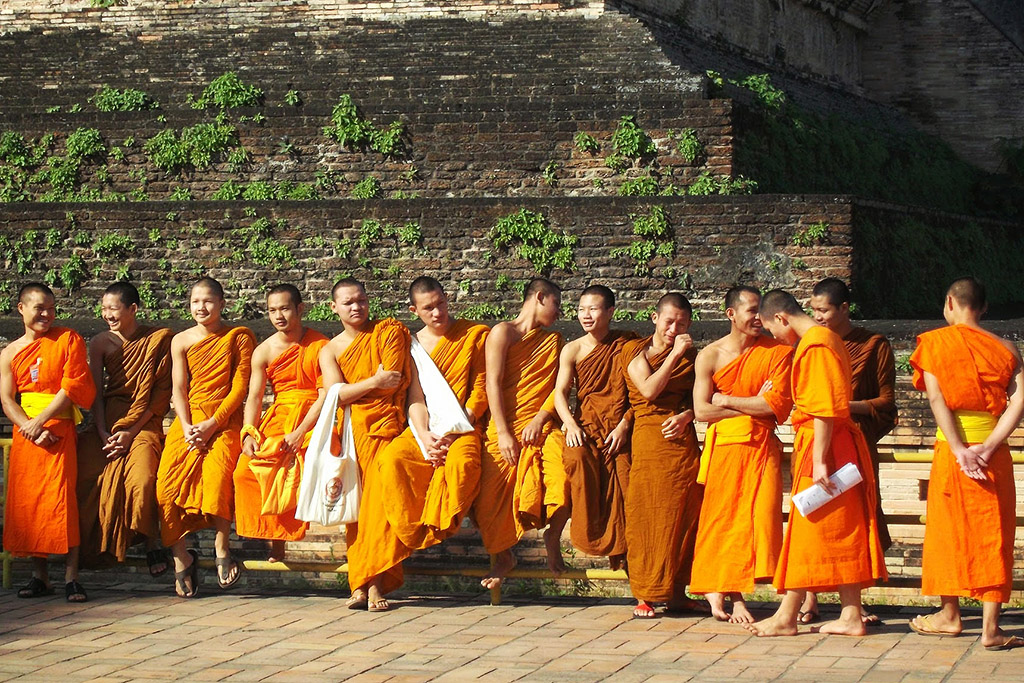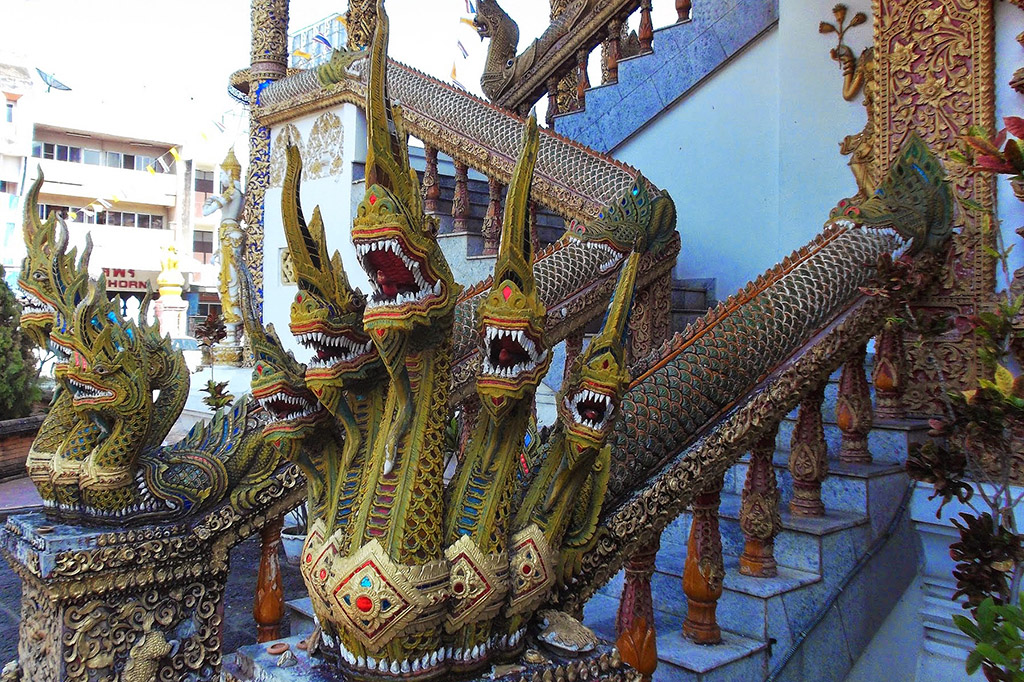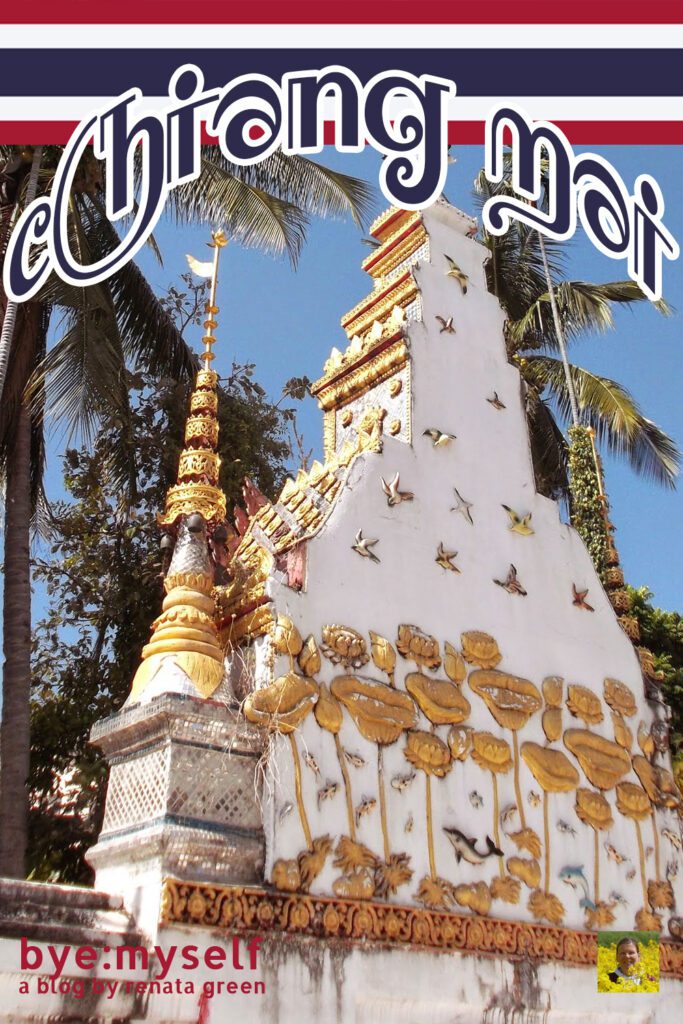Yes, there are about 200 Buddhist Wats in the glorious city of Chiang Mai – and for a start, I’ve handpicked the ten best temples for you!

If I had the chance to visit only one place in Thailand, it would definitely be Chiang Mai.
For the number and variety of those breathtakingly beautiful houses of worship, for the lovely coffee shops, for the charming little stores, for the good massage places, for the fact that they offer language lessons, for the perfect mix of traditional and historical and modern and hip.
Did I make myself clear? I love this place!
The Rose of the North
Chiang Mai – for its scenic beauty referred to as the Rose of the North – is the largest and culturally most important city in the northern region of Thailand.

King Mangrai founded Chiang Mai in 1296. After the subjugation of the Mon empire, Chiang Mai became the capital of his kingdom Lan Na. In 1556, the Burmese made Lan Na their vassal and it was not until 1775 that Chiang Mai came to Thailand under General Taksin, but retained a quasi-autonomous status until 1932.

Seeing Chian Mai’s beauty and thinking about its rich history makes you wonder why this jewel is not on the UNESCO World Heritage List – yet, it isn’t. Albeit, since 2017, it is on the UNESCO Creative Cities Network for its crafts and folk arts.

Nevertheless, to me, Chiang Mai’s fascination lies in the head-spinning number of beautiful temples. Every single one of them is different in material and design, yet all of them are incredibly impressive and I didn’t get tired of visiting them.
Top Ten Temples
It was very hard, but I did it: I put together a list of the ten nicest temples in wonderful Chiang Mai. The order reflects their objective importance as well as my subjective preferences.

After all, it’s silly to pick ten of 200, so go and see for yourself. You would think, 200 temples, that must be drab, but actually, it’s not at all since they are all so different. Already the various construction material makes each one unique, then they are all so sumptuously decorated. I’m just an ordinary tourist and no expert at all, and still, they somehow cast a spell over me.
Wat Phra That Doi Suthep
Chiang Mai’s most important temple and landmark Wat Phra That is located about 15 kilometers west of the city center on the slopes of Doi Suthep mountain.

Yes, she is cute, but it’s her job to be cute, so I have strongly mixed feelings about this.
To get to the actual temple, you have to climb over 300 steps of a stone staircase. But don’t worry, the gorgeous railings will distract you from your exercise. They are made of lavishly decorated Nagas, hence snakes.

The most important feature is an octagonal Chedi, covered with gilded copper plates. Supposedly, it contains a relic of the Buddha. It is surrounded by a square fence, the upper half of which is gold-plated. At the four corners, there are filigree chats and ceremonial umbrellas in Burmese style.

Several rows of smaller bells hang in the forecourt. Pilgrims struck them with a wooden clapper. However, there is also a bell tower housing a gong of about 2 meters in diameter.

An open gallery surrounds the actual sanctuary of the temple. On the inner walls of the walkway, there are wall paintings from more recent times that illustrate the life of the Buddha.

On the inner walls of the southeastern Viharn are murals depicting the legend of the founding of the temple.
How To Get There
While I toured all the other temples in this list walking, this is not possible when visiting Wat Phra That. But you don’t have to join an expensive tour or hire a cab. Just go to the Chang Puak Gate and cross the road. There is a stop for songthaews, hence buses, that go to Doi Suthep charging around 50 THB per person.
Wat Chiang Man
This was actually Chiang Mai’s first temple. It stems from 1297 and was built on the site where King Mangrai had made camp to oversee the construction of his new capital.

The oldest structure is the Chedi Chang Lom. A gilded tip in the typical Lan Na style stands on a two-story cubic base. Fifteen life-size elephant statues seem to be carrying the structure on their backs.

In front of the Ubosot, the ordination hall, is a stone stele from 1581. This stele is the oldest evidence of the founding of Chiang Mai: April 12, 1296 at 4 a.m. The current building, however, probably dates from the 19th century.
Wat Phra Singh
King Pha Yu founded Wat Phra Singh in 1345 by building a Chedi to bury the ashes of his father, King Kham Fu. During restoration work in 1925, three urns were discovered in a small Chedi. They actually may contain the royal ashes.

In 1367, the famous Buddha statue of Phra Sihing was erected here. He gave this temple its name.
In the 18th century, the Wat was abandoned and left to decay due to the Burmese occupation. Then, in 1782, King Kawila came to power. He had the Ubosot rebuilt and the chedis expanded. His two successors built the Wihan Lai Kham and the elegant library.

The famous monk Khru Ba Sri Wichai organized the renovation of the entire temple in the 1920s. Most of the buildings received another renovation in 2002, with new gold leaf applied and the stucco decorations renewed.
Every year for the Songkran festival, the Phra Sihing is carried in a magnificent procession through the streets of the city. The faithful pay him homage by pouring water on him.
Wat Chedi Luang
Wat Chedi Luang’s history begins in the 14th century when King Saen Mueang Ma wanted to keep his father’s ashes here. However, after ten years of construction, the buildings remained unfinished. It was only when the King himself died that his widow continued the construction.

Probably due to structural problems, King Tilokaratcha did not complete the complex until the middle of the 15th century. With a height of 82 meters and a diameter of 54 meters at the base, it was the tallest building in Lan Na at the time.

Since 1468, an Emerald Buddha was sitting in the east-facing niche. In 1545, the roof collapsed due to an earthquake. Eventually, the Emerald Buddha was taken to Luang Prabang in northern Laos.

In the early 1990s, the Chedi was reconstructed with the help of UNESCO and the government of Japan.

In 1995, celebrating the Chedi’s 600th anniversary, a copy of the Emerald Buddha made of black jade was placed in the eastern niche.
Wat Phan Tao
Many visitors overlook this beautiful wooden temple, probably because it stands next to the famous Wat Chedi Luang. However, it’s totally worth the visit. Especially when during high season, tourists flood the more famous Wats, you will cherish this temple’s serenity. Also, the artistic and refined carving will simply mesmerize you.

As you enter, the main prayer hall made from dark teak wood is to your right. Inside is a gold image of the Buddha. A walkway on your left leads you to the stupa at the back.
This Wat also served as a palace.
Wat Lok Moli
This Buddhist temple is on the north side of the moat surrounding the old town.
It was first mentioned in a document in 1367. The 6th King of the Mengrai Dynasty of the Lan Na Kingdom invited a group of 10 monks from Burma to his country to live in this temple and to spread their teachings of Theravada Buddhism.

King Ket Chettharat ordered the construction of the Chedi in 1527 and later the construction of the ordination hall in 1545.
The royal family kept the ashes of several members of the Mengrai dynasty in this temple and took responsibility for maintaining the Wat till the end of their dynasty.
The Chedi, made of bare bricks, stands out from the numerous, often freshly plastered, painted, or gilded buildings in Chiang Mai. Other peculiar features are the delicate Naga sculptures and the Viharn. The latter is made of precious woods. Oddly, it is on a north-south axis while most Buddhist temples are facing east, hence, towards the light of the rising sun.
Wat Khuan Khama
Directly across from Wat Lok Mo Li is Wat Khuan Khama, the horse temple. You can see many of the gilded horse statues already from the street.

On the premises, there are a couple of other animal statues that are based on the Chinese calendar. It goes without saying that also rats, cows, and snakes are not missing.
Wat Khuan Khama is a perfect example of Chiang Mai’s cultural wealth. Everywhere else, this fine house of worship would be the center of attention. Here, it’s just another Wat and hardly ever mentioned in lists of Chiang Mai’s temples’n’treasures.
Wat Buppharam
This Wat has a close connection to the former royal house of Chiang Mai. In 1497King Phra Mueang Kaeo commissioned this temple on the site of an earlier palace by his great-grandfather, King Tilokarat.

As the Burmese conquered the city in 1561, they settled monks of the Mon in the temple.

In the 19th century, the princes of Chiang Mai, supported by the city’s population, initiated the restoration of the temple.
Wat Saen Fang
This Buddhist temple stems from the 15th century. However, all extant structures date to the 18th century – or even later.
The Viharn previously served as the Emperors’ royal residence in the 19th century.

The Burmese-style gilded Chedi is one of the temple’s most beautiful features. The Ubosot, hence the ordination hall, is a fusion of Burmese and Lan Na styles.
Wat Sri Suphan
Silver is covering Wat Sri Suphan from the walls to the roof. It shows also some detailed silver carvings of Buddhism legends. Even the statues of Buddha are silvern.

This temple dates back to around 1500 when it was the main temple for a – you might have guessed so – silversmith village. Over the years silver from the local village was used to repair parts of the temple. Then in 2008, the thought, oh what the heck, and covered the entire thing in silver.

The inside of the temple is supposedly even more interesting with silver decorations, mirrors, and bright colors mixed together. But what do I know, I’m just a woman, after all. Because due to old Buddhist rules, women are not allowed inside the temple. Isn’t it nice that all religions have at least one thing in common – namely, misogyny.
However, the unwanted gender finds small silver studios on the premises. Here, we can see artists at work. Fortunately, we women are also allowed to buy or commission works of silver from them.
Massage
Very recommendable is to get a massage in Chiang Mai by ex-cons – or even cons – of the women’s prison. This way, not only do you feel good – you also do good, because with this job, the women – mostly in there for drug trafficking, so no mass murderers – can start a new life.
Map
Here is a map that will certainly help you find all those mesmerizing places I’m introducing above:
Practical Information
How to Get There
Since the Rose of the North is located….north and quite far from the other places of significance, you have basically two good options for getting there.

One is, obviously, flying into Chiang Mai airport. The airport is located only four kilometers southwest of the city center. It has a terminal for domestic flights and a terminal for international flights. However, those are connecting the city only with other destinations in South East Asia.
A great way to get to Chiang Mai is by train. If you opt for the night train, not only do you save time but also money for accommodation.

The train leaves Bangkok and makes stops i. a. at Ayutthaya, Lopburi, and Phitsanulok before arriving in Chiang Mai in the early morning.
Obviously, you can also travel to and from Chiang Mai by bus. There are two terminals at the Arcade Bus Station located about three kilometers east of the city center. There is also a night bus to Bangkok, however, I sleep far better on trains.
How to Get Around
Chiang Mai’s travel hubs are quite far from the old center. You’ll always have to take a tuk-tuk, a shared taxi, or hire a cab to get to the airport, train station, or bus terminal.

Apart from few exceptions, Chiang Mai can comfortably be visited walking. Just like in Kamphaeng Phet or Sukhothai, you can also explore the city and its outskirts by bicycle. Often, you can borrow a bike at your hotel for free or sometimes for a very small fee. However, there are also bike rentals downtown. Nevertheless, since most of the sights are within the city limits, I find cycling the narrow streets riding around cars and pedestrians a bit unnerving.
Where to Stay
As a matter of fact, my accommodation, the Hotel California – please don’t laugh and don’t hum this evergreen – is located just around the corner from the most important temples right on the main Rachadamnoen Road. Nevertheless, it’s a bit too downscale. Across the street, though, is the far better hotel U Chiang Mai*.
Anyway, there are many lodging options for each budgets in Chiang Mai so that you might want to check them out on this map*:
Booking.comWhat to Eat
Chiang Mai is a touristy spot with a dizzying choice of eateries for every budget.
However, I’d like to recommend joining the Dinner Show at Old Chiang Mai Cultural Center. I know it sounds a bit like Disney Land and super cheesy, but actually, it’s really nice. Actually, there weren’t even so many foreign tourists there – they probably think it’s cheesy while the local tourists enjoy it; the world is a funny place.

I got there in the afternoon and was able to get a ticket for the same evening.

The guests are seated on the floor around a ground-leveled stage. While you are enjoying a typical Thai menu, artists perform various fancy traditional dances.

After dinner, you can take pictures and shop for local handicrafts before a more rural’n’rustic performance takes place. Those dancers perform in a wooden shack around a fireplace.
Cash And Cards
Chiang Mai is a very touristy area, hence, credit cards are widely accepted. Obviously, there are Banks with ATMs – principally along the main road Thanon Jarodvithi Thong
As of January 2023, one US-Dollar equals 35 Baht (THB), but you can check the current rate on this page.
Language
Apart from Bangkok, Chiang Mai was the only place that fulfilled my expectation everyone would speak English at least rudimentarily.
However, trying to buy some body lotion without whitener was a real challenge. The poor saleswoman had no clue what I was asking her – although I found my charade quite clear.
This being said, obviously, it’s a nice gesture to say at least the greeting Sawasdee Kha and Sawasdee Khun as well as Khop Khun Kha respectively Khop Khun Khap. Kha is a suffix used by women, men are using Khap.
Communication and Connection
Unfortunately, Chiang Mai is also deteriorating into one of those places flooded by digital nomads. Therefore, there is an internet connection practically everywhere.
Nevertheless, if you want to be sure that the hotel of your choice has good Wi-Fi, I recommend you check the quality beforehand. You’ll find the link in my post World’s Most Complete Travel Information which is an indispensable globetrotter-classic, anyway.
Chiang Mai was only one of the destinations I visited during my exciting trip to Thailand. So go to the main post to check out all the other destinations. There you’ll also find valuable general information that will make your trip smoother.
Pinnable Pictures
If you choose to pin this post for later, please use one of these pictures:






Note: I’m completing, editing, and updating this post regularly– last in January 2023.
So did You Enjoy This Post? Then You Might Like Also These:
KAMPHAENG PHET and PHITSANULOK – two (un)necessary detours
Island Hopping in the Andaman Sea – Koh Phi Phi, Koh Lanta, Koh Jum
THAILAND – all the must-see places
From the Sunken Kingdom of AYUTTHAYA to the Monkey Temple of LOPBURI
KRABI and AO NANG – the Gateway to Paradise
24 hours in BANGKOK
CHIANG MAI – Ten out of 200 Temples
SUKHOTHAI – 200 temples at your choice
* This is an affiliate link. Hence, if you book through this page, not only do you get the best deal. I also get a small commission that helps me run this blog. Thank you so much for supporting me!








I’ve been to Thailand numerous times but never actually made it to Chang Mai. When I do, this is a fab guide as I think 200 temples is too much of an overwhelming choice for me! Top 10 is way easier so thank you. Also love the idea of getting a massage by the ex-prisoners & agree, feeling good while doing good is a great bonus. Thanks for sharing & helping me prioritise.
Chiang Mai is definitely one of my favorite spots in Thailand. Apart from all those amazing sights, it also has a very pleasant vibe.
We travelled in Thailand at the same time our adult son was there. While we lounged in Krabi, he and his friend headed off by scooter to Chiang Mai. The pics he sent made me wish we joined him. This post adds so many other reasons for us to visit. And adds the history that my son really did not pass on. We would probably fly and pass on that overnight train.
I totally understand, however, taking the train was a very special experience – and actually very comfy 😉